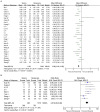Immune-Inflammatory Parameters in COVID-19 Cases: A Systematic Review and Meta-Analysis
- PMID: 32582743
- PMCID: PMC7295898
- DOI: 10.3389/fmed.2020.00301
Immune-Inflammatory Parameters in COVID-19 Cases: A Systematic Review and Meta-Analysis
Abstract
Background: The recent outbreak of coronavirus disease 2019 (COVID-19) has been rapidly spreading on a global scale and poses a great threat to human health. Acute respiratory distress syndrome, characterized by a rapid onset of generalized inflammation, is the leading cause of mortality in patients with COVID-19. We thus aimed to explore the effect of risk factors on the severity of the disease, focusing on immune-inflammatory parameters, which represent the immune status of patients. Methods: A comprehensive systematic search for relevant studies published up to April 2020 was performed by using the PubMed, Web of Science, EMBASE, and China National Knowledge Internet (CNKI) databases. After extracting all available data of immune-inflammatory indicators, we statistically analyzed the risk factors of severe and non-severe COVID-19 patients with a meta-analysis. Results: A total of 4,911 patients from 29 studies were included in the final meta-analysis. The results demonstrated that severe patients tend to present with increased white blood cell (WBC) and neutrophil counts, neutrophil-lymphocyte ratio (NLR), procalcitonin (PCT), C-reaction protein (CRP), erythrocyte sedimentation rate (ESR), and Interleukin-6 (IL-6) and a decreased number of total lymphocyte and lymphocyte subtypes, such as CD4+ T lymphocyte and CD8+ T lymphocyte, compared to the non-severe patients. In addition, the WBC count>10 × 109/L, lymphocyte count<1 × 109/L, PCT>0.5 ng/mL, and CRP>10 mg/L were risk factors for disease progression in patients with COVID-19 (WBC count>10 × 109/L: OR = 2.92, 95% CI: 1.96-4.35; lymphocyte count<1 × 109/L: OR = 4.97, 95% CI: 3.53-6.99; PCT>0.5 ng/mL: OR = 6.33, 95% CI: 3.97-10.10; CRP>10 mg/L: OR = 3.51, 95% CI: 2.38-5.16). Furthermore, we found that NLR, as a novel marker of systemic inflammatory response, can also help predict clinical severity in patients with COVID-19 (OR = 2.50, 95% CI: 2.04-3.06). Conclusions: Immune-inflammatory parameters, such as WBC, lymphocyte, PCT, CRP, and NLR, could imply the progression of COVID-19. NLR has taken both the levels of neutrophil and lymphocyte into account, indicating a more complete, accurate, and reliable inspection efficiency; surveillance of NLR may help clinicians identify high-risk COVID-19 patients at an early stage.
Keywords: COVID-19; immune-inflammatory parameters; meta-analysis; neutrophil-lymphocyte ratio; risk factor.
Copyright © 2020 Feng, Li, Sun, Zhu, Chen, Xiong and Cao.
Figures







References
Publication types
LinkOut - more resources
Full Text Sources
Research Materials
Miscellaneous

